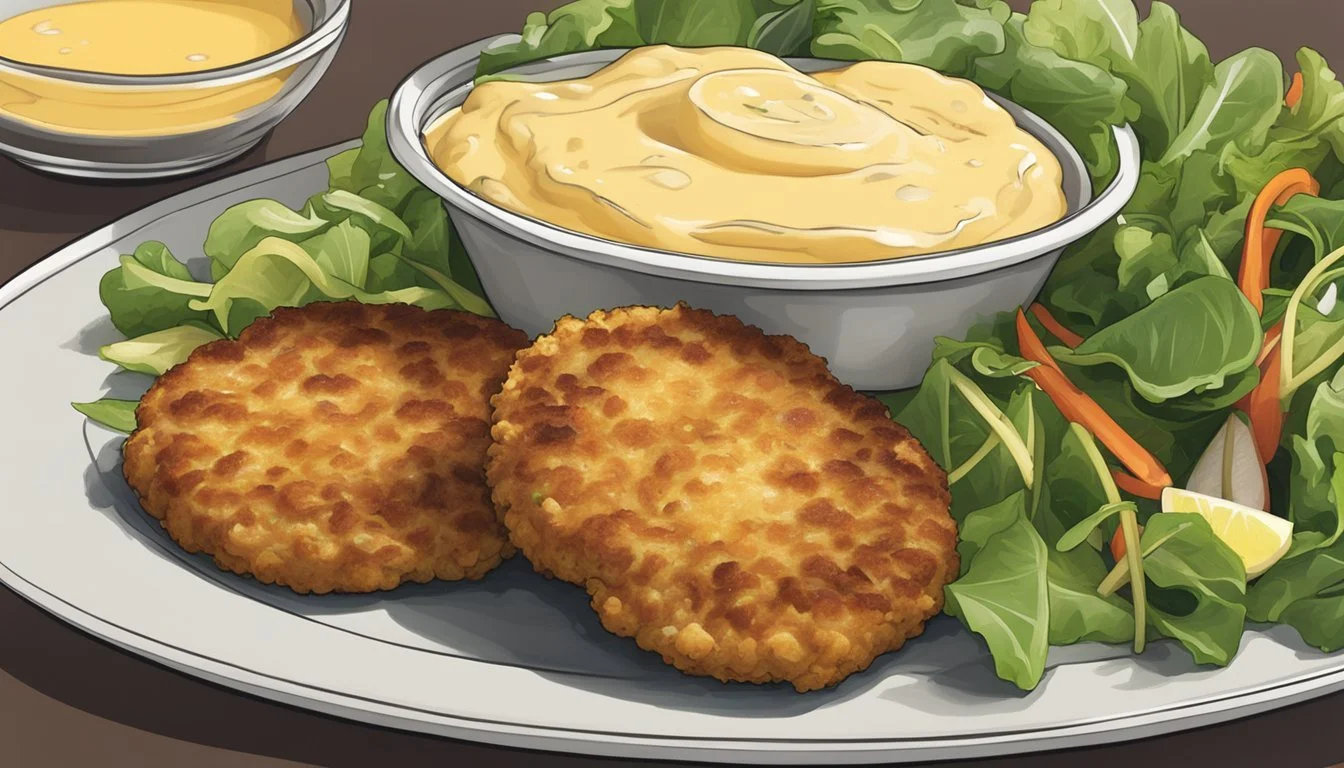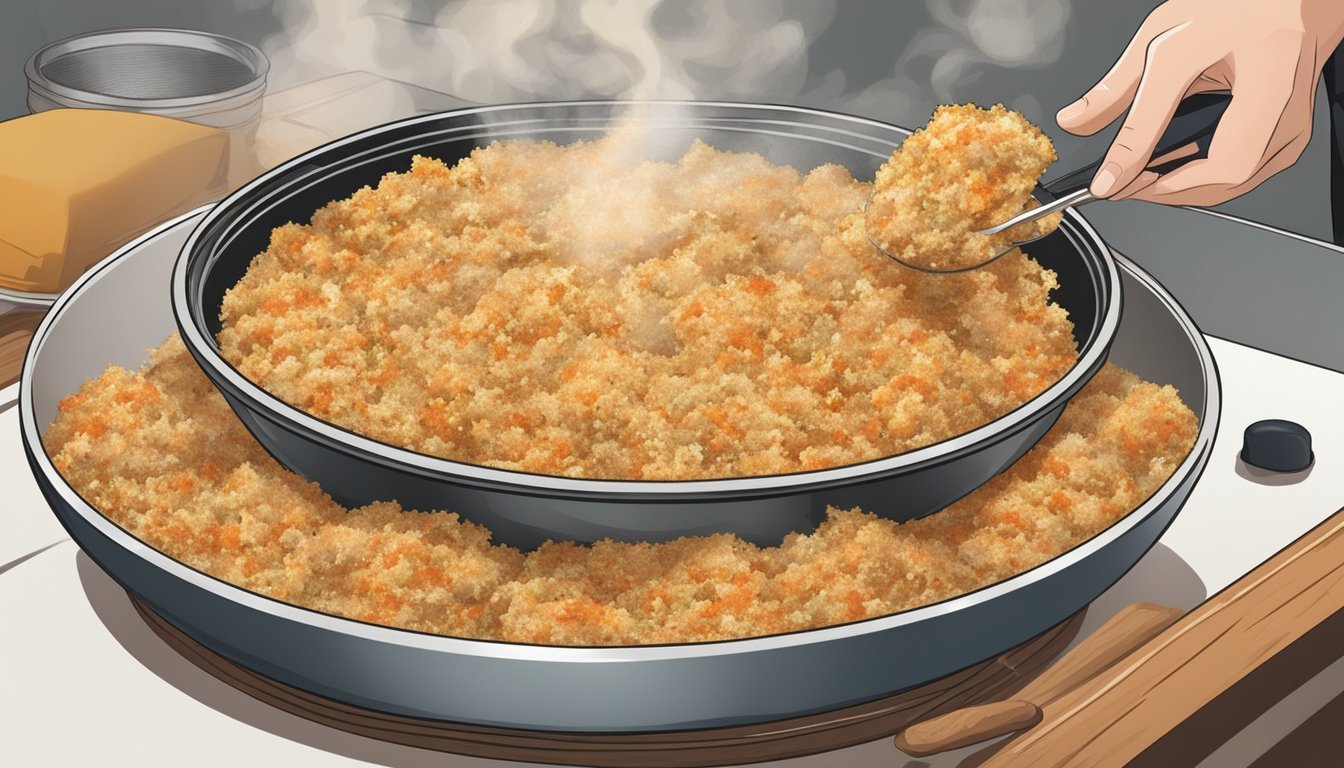Are Crab Cakes Gluten-Free?
Understanding Their Ingredients and Preparation
Crab (What wine goes well with crab?) cakes have long been a favored dish, often characterized by their rich flavor and tender consistency. However, individuals with gluten intolerance or celiac disease face the challenge of determining which foods align with their dietary restrictions. Notably, traditional crab cake recipes may include breadcrumbs or other gluten-containing binders, placing them outside the realm of gluten-free cuisine.
The good news is that crab cakes can be made gluten-free. Recipes adapted for gluten-sensitive individuals replace wheat-based ingredients with alternatives such as gluten-free breadcrumbs, crushed crackers, or even minced vegetables to maintain the desired texture. Making these substitutions allows those on gluten-free diets to enjoy crab cakes without compromising on taste or texture.
The key to ensuring crab cakes are indeed free from gluten lies in diligent ingredient selection and preparation methods. This means scrutinizing every component, from the crab meat to the seasoning blends, as they can sometimes contain hidden gluten. Additionally, for those who are particularly sensitive, it is crucial to avoid cross-contamination with gluten-containing products during preparation and cooking.
What Are Crab Cakes?
Crab cakes are a classic seafood dish known for their savory flavor and delightful texture. They serve as a versatile culinary staple that can be enjoyed as a main dish or an appetizer.
Definition and Origin
Crab cakes are a type of seafood cake that is composed primarily of crab meat and various other ingredients that can include breadcrumbs, mayonnaise, eggs, and seasonings. They are shaped into rounds or patties and are typically pan-fried, baked, or grilled until golden and crisp. Originating from the Chesapeake Bay region, Maryland-style crab cakes have become the standard in the United States for their simplicity, which highlights the crab's delicate flavor.
Popular Variations
Throughout the culinary world, chefs and home cooks alike have created numerous variations of crab cakes to suit differing tastes and dietary requirements. The following list includes some of these popular variations:
Maryland-style Crab Cakes: Focus on the flavor of the blue crab with minimal filler ingredients.
Gluten-Free Crab Cakes: Use alternatives like gluten-free breadcrumbs or panko, appealing to those with gluten sensitivities.
Creole Crab Cakes: Incorporate spices and ingredients typical of Creole cuisine, adding a robust flavor profile.
Crab cakes have earned their reputation as a cherished seafood dish, whether served on a white tablecloth or a casual brunch. They can be dressed up with rich sauces or simply accompanied by a slice of lemon, providing a versatile choice for seafood lovers.
Understanding Gluten in Crab Cakes
Crab cakes traditionally contain gluten, which is mainly found in the filler ingredients used to bind the cakes together. For those looking for gluten-free options, understanding where gluten may be present is essential.
Role of Gluten in Traditional Recipes
In traditional crab cake recipes, gluten plays a crucial role as a binding agent that helps maintain the shape and texture of the cake. Gluten, a protein found in wheat, barley, and rye, gives elasticity to dough and helps it rise and retain its shape. Gluten-containing fillers such as regular breadcrumbs, wheat flour, or crackers are commonly used to add volume and hold the crab meat together. The persistence of gluten in these recipes creates a challenge for individuals with celiac disease or gluten intolerance who must avoid these proteins to maintain their health.
Sources of Gluten in Crab Cakes
The most prevalent sources of gluten in crab cakes come from:
Breadcrumbs/Bread Crumbs: These are often used as a filler to provide texture and bulk. Traditional breadcrumbs are made from wheat flour, which contains gluten.
Crackers: Some recipes use crushed crackers as a filler, most of which are made from wheat flour unless specified as gluten-free.
Panko Breadcrumbs: A type of light, airy breadcrumb commonly used for a crispier texture. Standard panko is made from wheat flour and is not gluten-free.
For those requiring a gluten-free diet, replacements for these ingredients might include gluten-free breadcrumbs or gluten-free crackers, which are specifically formulated without gluten-containing grains. In gluten-free crab cake recipes, alternative binders that are gluten-free must be used to achieve a similar consistency and coherence without compromising the dietary needs of those avoiding gluten.
Ingredients for Gluten-Free Crab Cakes
Crafting gluten-free crab cakes requires careful selection of crab meat and replacement of traditional binding and flavoring agents with gluten-free alternatives. A suitable coating is also paramount to ensure the cakes maintain their texture while adhering to gluten-free standards.
Selecting Suitable Crab Meat
For the main ingredient, crab meat, options range from fresh crab meat to canned varieties. Fresh offers the best flavor, but canned can be more convenient. The types of crab meat include:
Jumbo lump crab meat: large, whole pieces ideal for a premium look and texture.
Lump crab meat: smaller than jumbo but still offers a substantial texture.
Backfin: a mix of smaller lump pieces and flaked meat.
Claw meat: darker and with a stronger flavor, adding depth to the cakes.
Gluten-Free Binding and Flavoring Agents
Binding and flavoring agents are essential for structure and taste. Replace traditional wheat-based binders with gluten-free alternatives:
Binding agents:
Egg: natural binder that helps hold the cakes together.
Mayonnaise: adds moisture; opt for gluten-free mayonnaise if needed.
Flavoring agents include:
Dijon mustard and gluten-free Worcestershire sauce: for subtle tang and depth of flavor.
Lemon juice, parsley, and seasoning such as Old Bay or pepper: for a fresh, vibrant taste.
Gluten-Free Coating Options
A crusty exterior is achievable with gluten-free alternatives:
Gluten-free panko breadcrumbs: light and crispy, mimic traditional panko.
Almond flour: gives a nutty flavor and pleasant texture.
For baking, a light brush with olive oil or melted salted butter promotes browning and enhances flavor.
Preparing Your Gluten-Free Crab Cakes
Crafting gluten-free crab cakes involves thoughtful recipe development, proper techniques for mixing and shaping, and the application of various cooking methods. It's essential to choose gluten-free alternatives at every step to ensure the end product is safe for those with gluten sensitivities.
Recipe Development
The development of a gluten-free crab cake recipe begins with selecting gluten-free alternatives for typically gluten-containing ingredients. Breadcrumbs or crackers, for instance, can be replaced with gluten-free panko or crushed gluten-free crackers. A mixture of seasoning such as paprika, garlic, and onion powder adds flavor, while diced bell peppers or red pepper give a satisfying crunch. To bind the cakes together without using traditional wheat flour, one might opt for ingredients like a gluten-free flour blend or even oats.
Prep time: An estimated 15-20 minutes for gathering and preparing ingredients. Cook time: Varies; approximately 3-5 minutes per side if fried, or up to 15 minutes in an oven or air fryer. Total time: This can range from 30 minutes to an hour, depending on the chosen cooking method and any additional chilling time.
Mixing and Shaping
Once the ingredients are selected, they are gently mixed to form the crab cake mixture. This process often starts with whisking together wet ingredients like dairy-free or vegan mayonnaise and mustard to ensure even distribution. The crab meat—ensuring it's free from any shell fragments—is then carefully folded into the mixture along with the gluten-free binding agents.
To shape the crab cakes:
Measure out desired portions, commonly around 3 inches in diameter.
Gently press the mixture together to form patties.
If the mixture is too loose, additional gluten-free binder may be added.
Chilling the crab cakes before cooking can help maintain their shape and makes them easier to handle. Ensure a chilling time of at least 30 minutes in the refrigerator.
Cooking Techniques
Gluten-free crab cakes can be cooked using several methods:
Fried: In a nonstick pan or cast iron skillet, heat a suitable amount of canola oil, vegetable oil, or avocado oil over medium heat. Fry the cakes until they are golden brown and reach an internal temperature of 165°F.
Baked: Preheat the oven to 370°F and place the cakes on a parchment-covered baking sheet. Bake until heated through and crisp on the outside, often 10 to 15 minutes.
Air Fryer: If using an air fryer, cook the crab cakes in a single layer at a temperature typically between 370°F to 400°F, until golden and crispy.
Serve the crab cakes hot, accompanied by lemon wedges for a tangy flavor.
Serving and Accompaniments
When presenting gluten-free crab cakes, the selection of side dishes and accents should complement the delicate flavors of the crab. Thoughtful choices in accompaniments can elevate the dining experience.
Choosing Complementary Side Dishes
Serving gluten-free crab cakes as an appetizer sets the tone for a meal that's both refined and accommodating to dietary restrictions. For a balanced plate, one should consider pairing them with:
Vegetables: Lightly steamed asparagus, sautéed spinach, or a fresh salad provide a healthy and vibrant contrast to the rich crab cakes.
Starches: Gluten-free options like quinoa salad or roasted potatoes are hearty sides that round out the meal without overwhelming the main dish.
These sides should not only add a spectrum of textures but also support the crab cakes as the star of the meal.
Sauces and Garnishes
The right sauce or garnish can transform a good crab cake into a great one. Each addition should enhance, not mask, the crab's natural flavor:
Sauces:
Tartar sauce and cocktail sauce are classic options that offer a tangy kick.
For a more subtle choice, garlic aioli or a simple aioli sauce adds creaminess with a hint of garlic.
Garnishes:
A squeeze of lemon juice or a few lemon wedges on the side invite a refreshing acidity.
A sprinkle of chopped parsley not only adds color but a fresh, herbal note to each bite.
These accents should be applied with a light hand to complement the crab cakes without overpowering their natural flavor.
Nutritional Considerations
When assessing the nutritional profile of crab cakes, particularly gluten-free ones, one must consider their caloric content and the balance of macronutrients and micronutrients they contain. This will provide an understanding of their role in an individual's dietary needs.
Caloric Content
Gluten-free crab cakes' caloric value largely depends on the ingredients used and the cooking method. For instance, if a crab cake is pan-fried in a generous amount of oil, it may have a higher caloric content due to the oil absorbed during the cooking process. This can notably increase the total calories compared to baking or broiling.
Macronutrients and Micronutrients
Protein: Crab meat is an excellent source of high-quality protein, which is essential for muscle repair and growth. A typical serving of crab cakes can provide a substantial amount of an individual's daily protein requirement.
Fats: Crab cakes may contain different types of fats. Options to prepare them may include additives like mayonnaise, which contributes both saturated and unsaturated fats. Unsaturated fats are healthier for heart health, and one should limit the intake of saturated fats to reduce the risk of heart disease.
Saturated fat: Usually found in the ingredients added for binding and taste, such as butter or certain oils.
Unsaturated fat: Often present in healthier cooking oils that may be used for frying or in the crab meat itself.
Cholesterol and Omega-3: Crab meat naturally contains cholesterol, but it is also rich in omega-3 fatty acids, which have cardiovascular benefits. The balance of these nutrients should be considered, especially for those monitoring their cholesterol intake.
Gluten-free crab cakes can be part of a well-balanced diet when cognizant of these nutritional factors and prepared in a way that complements an individual's nutritional goals.
Storing and Reheating
Proper storage and reheating are crucial to ensure that crab cakes maintain their quality and texture. The methods used can affect their crispiness and flavor.
Short-Term Storage
For short-term storage, crab cakes should be kept in an airtight container and refrigerated. They can be safely stored like this for up to 3 days. The container will prevent them from absorbing other odors and maintain their freshness.
Freezing and Thawing
Crab cakes can be frozen to extend their shelf life. To freeze, place them in a single layer on a baking sheet, then transfer them to a freezer-safe bag or container once they're frozen. This prevents them from sticking together. They can be stored in the freezer for up to 3 months. When ready to eat, crab cakes should be thoroughly thawed in the refrigerator before reheating.
Reheating Methods
There are several methods to reheat crab cakes while preserving their crispness:
Oven: Preheat the oven to 325°F (163°C) and heat the crab cakes for 10-15 minutes.
Air Fryer: Reheat at 370 degrees F for about 8-10 minutes until they're golden brown.
Stovetop: Use a skillet over medium heat, add a bit of oil, and warm each side for 3-5 minutes until crispy.
Each of these methods aims to restore the crab cakes' texture and warmth without overcooking or drying them out.
Gluten-Free Crab Cake Variations and Substitutions
When preparing crab cakes, the challenge for those on gluten-free diets is avoiding all sources of gluten while maintaining the dish’s signature texture and flavor. This section examines specific dietary adjustments and alternative ingredients that align with gluten-free, keto, and dairy-free needs.
Dietary Adjustments
For those requiring strict gluten-free diets, traditional breadcrumbs must be replaced with gluten-free alternatives to eliminate the risk of gluten exposure. Store-bought gluten-free breadcrumbs or crushed gluten-free crackers can be used, or as a homemade solution, one can opt for almond flour or crushed pork rinds, particularly suitable for individuals following a keto diet.
To adapt crab cakes for a dairy-free diet, any butter or cream can be substituted with dairy-free variants like Greek yogurt (if only lactose-free is required) or simply omitted if full dairy elimination is needed. Eggs typically serve as a binding agent and are naturally gluten and dairy-free; however, in keto-friendly versions, more emphasis may be placed on eggs to substitute for fillers that are often high in carbohydrates.
Alternative Ingredients
Substitutions can extend to the aromatics and flavorings within crab cakes. Green onions or chives can be used in place of red onion to offer a milder onion flavor while remaining gluten-free. Some recipes suggest sautéing these ingredients lightly to bring out a sweeter profile before adding them to the crab cake mixture.
For the main substance of the crab cakes, one can choose between using fresh homemade crab meat or store-bought canned crab meat. When selecting canned crab meat, it is imperative to check labels for any gluten-containing additives.
Binding Agents: Gluten-free crumbs, almond flour, or even a small amount of coconut flour.
Dairy Substitutes: Coconut cream, almond milk (unsweetened), or olive oil instead of butter.
Seasonings: Gluten-free Worcestershire sauce and soy sauce alternatives like Tamari or coconut aminos to maintain the umami flavor profile.
By incorporating these substitutions, crab cakes can be easily tailored to fit a variety of dietary needs while still delivering a delectable experience.
Making Crab Cakes Without a Recipe
Crafting gluten-free crab cakes without a recipe can be a rewarding culinary adventure. Focusing on the balance of flavors and the consistency of the mixture is essential to form the perfect patties.
Tips for Free-Forming Crab Cakes
The foundation of free-forming crab cakes is choosing the right ingredients that bind together well, while still maintaining the crab's delicate flavor. An individual should start with quality crab meat, ensuring it's fresh and well-drained to prevent soggy cakes. The ideal binding mixture can include gluten-free panko breadcrumbs or crushed gluten-free crackers, and a bit of mayo to add moisture. Seasonings are paramount – a combination of sea salt, black pepper, and garlic powder brings out the crab's natural taste. For a little kick, mustard can be a great addition.
Binding Agents: Gluten-free panko or crushed crackers
Moisture: Mayo (a tablespoon is usually enough per cup of crab meat)
Seasonings: Sea salt, black pepper, garlic powder
To shape the cakes, it's helpful to have wet hands to prevent sticking and to ensure uniform sizes for even cooking.
Taste and Texture Considerations
Achieving the perfect gluten-free crab cake centers around the contrast of a crispy exterior with a juicy interior. The key to a crispy texture lies in how one cooks the cakes. Pan-frying in a nonstick pan with a bit of vegetable oil, such as peanut oil, can offer a golden crust while preserving the moist interior. The cakes should be cooked over medium heat to prevent burning – usually 3 to 5 minutes per side.
Exterior: Aim for a golden-brown crispiness.
Interior: The crab should be juicy and tender.
The texture also greatly benefits from chilling the formed crab cakes before cooking, which helps solidify the shape and ensures they don't fall apart in the pan.
When considering flavor, remember the crab should be the star. One should be generous but careful with seasoning, making sure to taste the mixture before forming the cakes. Too little will yield a bland cake, but over-seasoning can overwhelm the delicate crab.







